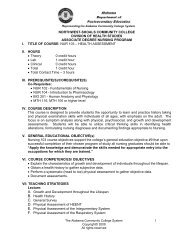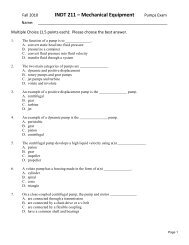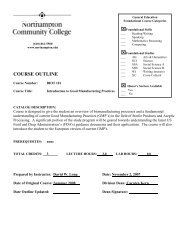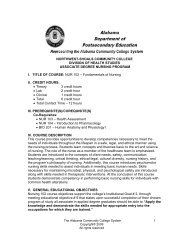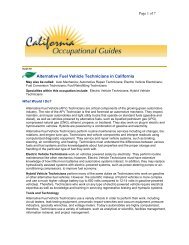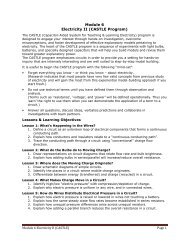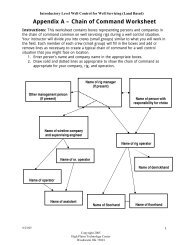i. Module 4 Fluids and Thermodynamics ... - Workforce 3 One
i. Module 4 Fluids and Thermodynamics ... - Workforce 3 One
i. Module 4 Fluids and Thermodynamics ... - Workforce 3 One
Create successful ePaper yourself
Turn your PDF publications into a flip-book with our unique Google optimized e-Paper software.
Lesson 5: How Heat FlowsText <strong>and</strong> Activities are from NeoSci How Heat Flows programEarly scientists believed that heat was an invisible, weightless fluid capable of flowing fromhotter objects to colder ones. They called this fluid substance "caloric."It was not until 1798 that scientists finally got on the right track in explaining the truenature of heat. Benjamin Thompson, who became known as Count Rumford, was anAmerican who went to Bavaria to help in the boring of cannon barrels. He observed that thecannon <strong>and</strong> the boring tools became hot as the drilling progressed <strong>and</strong> that, even when theboring tools became dull <strong>and</strong> little material was being removed, heat continued to begenerated. Thus, he concluded that the heat generated was related to the work done <strong>and</strong>was, in fact, just another form of energy.Forty years after Count Rumford's observations, a British scientist named James PrescottJoule performed a series of experiments that supported the relationship between heat <strong>and</strong>motion. Combining all of the facts known about heat, we currently use the followingdefinitions: thermal energy is the energy associated with the internal motion of molecules inmatter <strong>and</strong> heat is thermal energy in transfer.Thermal energy is transferred in three ways:ConductionConvectionRadiationThermal energy is transferred from one substance to another by directcontact.Transfer of thermal energy that takes place in liquids <strong>and</strong> gasesTransfer of thermal energy that takes place through space, includingthrough vacuum, such as in the case of energy transfer from the sunHeat <strong>and</strong> TemperatureA misconception held by many people is that temperature <strong>and</strong> heat are the same. Althoughtemperature <strong>and</strong> heat are related, they are not the same. Heat is thermal energy intransfer, <strong>and</strong> temperature is the measure of this form of energy. The old terms from calorictheory still remain, <strong>and</strong> a common unit of measure for heat is the "calorie." The calorie isdefined as the amount of energy that must be added to one gram of water to make itstemperature increase by one degree Celsius, from 14.5°C to 15.5°C.Heat is in fact molecular vibrations in any substance. The hotter something is, the more themolecules in that substance vibrate. Temperature is a measurement of these tiny vibrations.The more vigorous the vibrations, the higher the temperature.Matter can exist in three phases: solid, liquid <strong>and</strong> gas. A phase change - such as solid toliquid or liquid to gas requires heat. The amount of heat needed to change 1 gram of asubstance from a solid phase to the liquid phase is known as the "heat effusion." Theamount of heat needed to change 1 gram of a substance from a liquid phase to a gas phaseis called "heat of vaporization."Solids, gases <strong>and</strong> liquids exp<strong>and</strong> when heated. When solids are heated, molecules movefarther away from their fixed position <strong>and</strong> from each other. This increased distance amongthe molecules accounts for the expansion of solids. Liquids also exp<strong>and</strong> as they are heated.An exception to this rule is water which, between the temperature of 4 °C <strong>and</strong> 0 °C,exp<strong>and</strong>s as it cools. Thermal expansion in gases is due to molecules moving faster <strong>and</strong>faster as the temperature increases.<strong>Module</strong> 4 Student Guide <strong>Fluids</strong> & <strong>Thermodynamics</strong> Page 24



